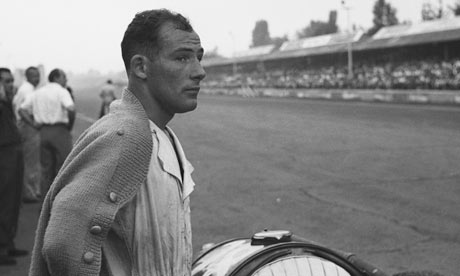MB History: Sir Stirling Moss

Stirling Moss told women they couldn’t. It’s quite sad to read his words. Sir Stirling is one of the greatest drivers to ever sit behind the wheel of a car. Moss’ own career was anything but easy. And that’s what makes his words all the more surprising and sad. Moss couldn’t win a world championship. He couldn’t win a world championship in a British made car, something he so desperately wanted. Moss’ own stubbornness and forces beyond his control never allowed him to have the career he should have had. He, more than anyone else, should know what it’s like for a driver to be kept from achieving what they deserve. Stirling Moss should know better than anyone else when you tell a driver they can’t race to win, they will risk life and limb to prove naysayers wrong.
May of 1948, citizens of the U.K. couldn’t buy a car and weren’t allowed to buy gasoline to power a car. An 18-year-old Stirling found himself in a single seat, motor bicycle engined, Cooper racecar in Gloucestershire. He had almost no experience in the Cooper having only driven the car a handful of times and around total of ten miles. Racing against drivers with ten times the experience, the adolescent should have folded under the pressure. When it was his turn to race up Prescott Hill, Moss logged a class record time. Later in the session his time was beaten, but he did take fourth place. The improbable career began to look a little less improbable.
So the young Englishman gave it a go at a career driving competitively. Moss preferred driving British kit and put his country’s machines up against foreign makes that were faster and more reliable than his own. The hill climb career that stated so brilliantly in 1948 with wins and fame, stalled when he stuck with British engine maker, J.A.P.. When the road was twisty, Moss kept pace. When he put his right foot to the floor and needed straight line speed, his Cooper was left behind. Moss refused to believe that raw talent could only take him so far.
More of the same was witnessed at the start of his Grand Prix career. Season after season Moss drove underpowered cars and could never take the fight to established teams. The cars he drove, H.W.M., E.R.A. , and Cooper-Atlas, were some of the worst on the grid. Moss shined in adversity and used all his skill to drive past the limits of the machine. But even with all his skill, Moss couldn’t be better than the best. He moved to Touring Trophy where British Jaguar was top car.
When Moss had the best, he was the best. He and his D-Type Jaguar won two years in-a-row. Trophies, honors, perfect stages, and endorsements made him a household name. He was so good that it was bigger news when he didn’t win. He conquered TT and was poised to move back to Formula 1.
1954 saw his return back to Grand Prix racing with the reluctant purchase of the foreign make 250F/1 Maserati. In a top tier car he was good. He could challenge the best, but still couldn’t triumph in the unreliable Maserati. The 1954 Italian Grand Prix epitomized his season.
1955 Mercedes Benz called for Moss to drive their machine, a machine that was superior to any other car on the grid. The drive was an opportunity that Moss couldn’t turn down. It did, however, mean taking the role of number two driver behind Juan Manuel Fangio, the reigning world champ. The season ended just as expected, with Moss strictly obeying team orders and finishing second. The two wins Moss had against the Argentine, Fangio that came at the British Grand Prix where Fangio may or may not have let Moss take victory at the last corner, and later at the famously dangerous Mille Miglia in a Mercedes Benz 300 SLR.
Serious about winning a championship in British kit saw Moss drive the 1957 season in a Vanwall. The car was quick but seriously fragile. Re-upping with Vanwall for the 1958 campaign the tense and ever determined Moss lost by a single point to Mike Hawthorn at the last race of the year in Casablanca, Morocco. The season coronated him as a great sportsman, when he magnanimously made sure Hawthorn’s results weren’t thrown out at Portugal, even when doing so would have made him odds on favorite to win the title he coveted.
Years 1959 to 1962 Moss became a private car owner and could never acquire the newest technologies that factory teams enjoyed. Some of his best driving and the series all-time best racing occurred in this period, but Maestro Moss couldn’t challenge the factories during the marathon that is a Formula 1 season.
1962 Moss crashed at Goodwood. The accident put him in a coma for a month and paralyzed his body for another 6. When recovered, he privately tested a Lotus and lapped a few tenths off times previously recorded in his lifetime. After the test he retired. He couldn’t control the car like he once could.
There’s a reason media outlets interview Stirling Moss. He raced in a time where every round had potential to be a driver’s last. The car, the course, or the odds never mattered to Stirling and that was realized by his driving style that was a mix of complete control and reckless abandon. A driver with his kind of talent doesn’t come along often and in Stirling Moss’ time, he was one of the few men that possessed the intangibles to race a car. He can’t take back his words now. What I do hope is that some driver of any gender, race, color, creed, will use Mr. Moss’ words as motivation and do what Sir Stirling never could.
